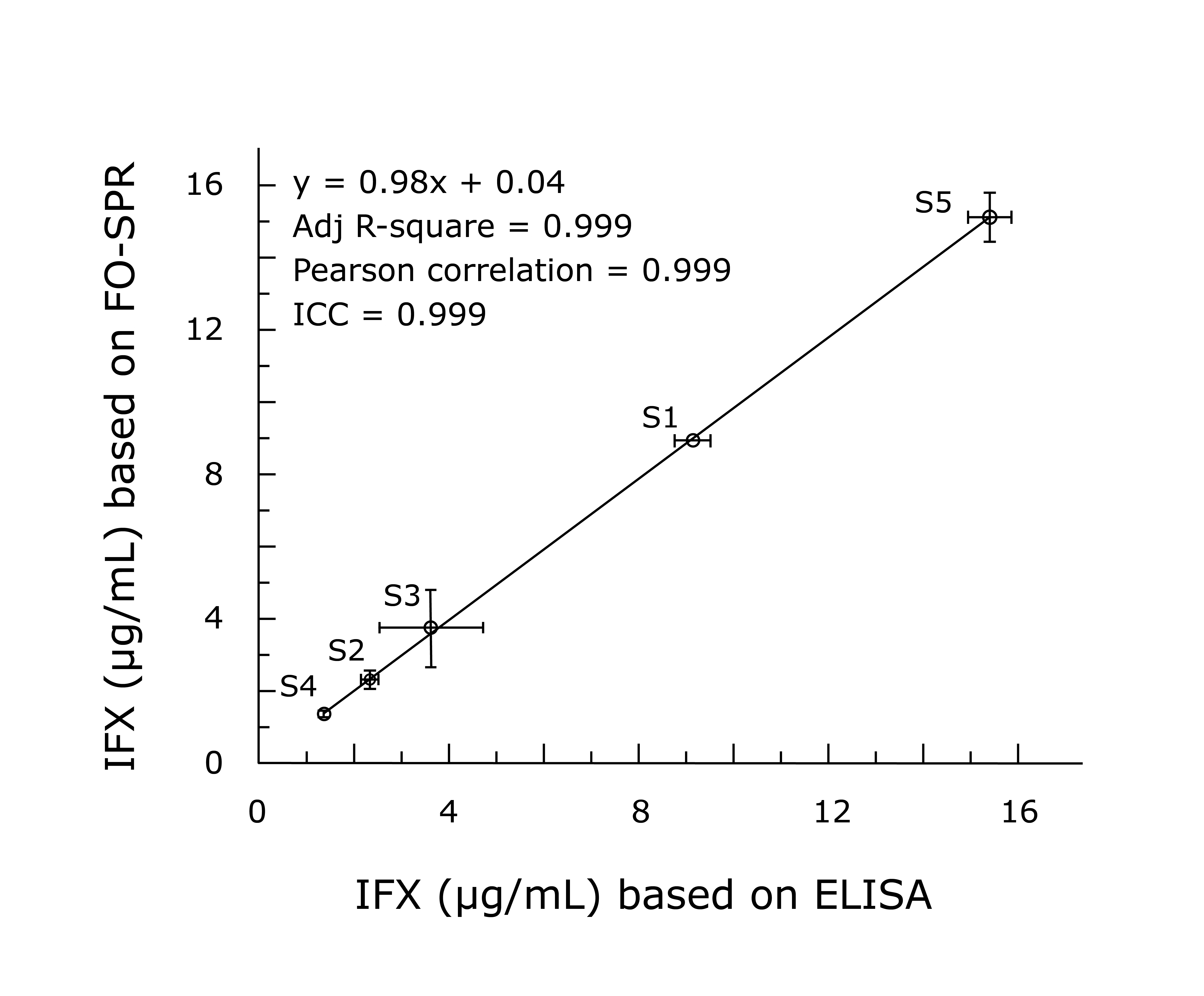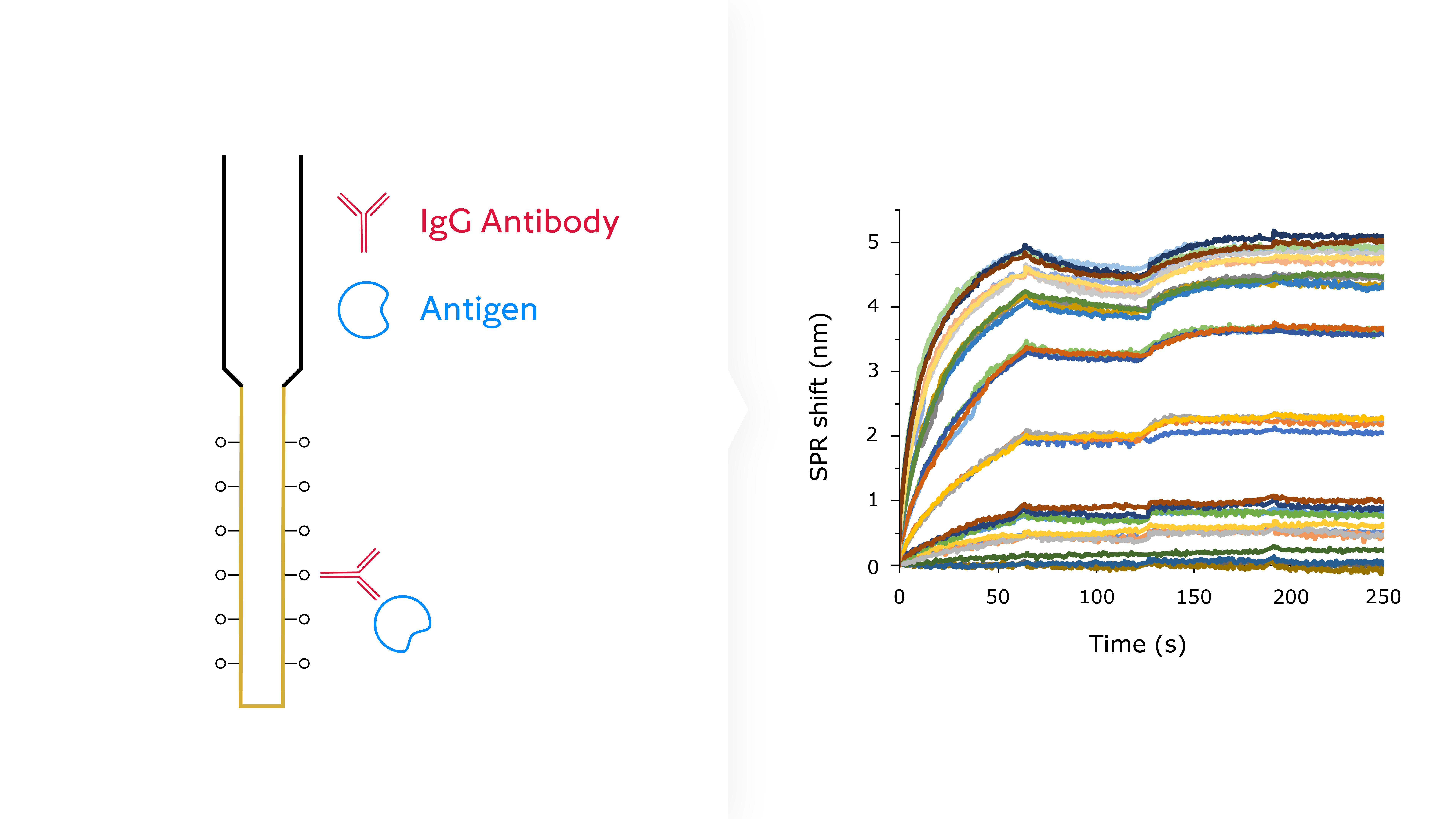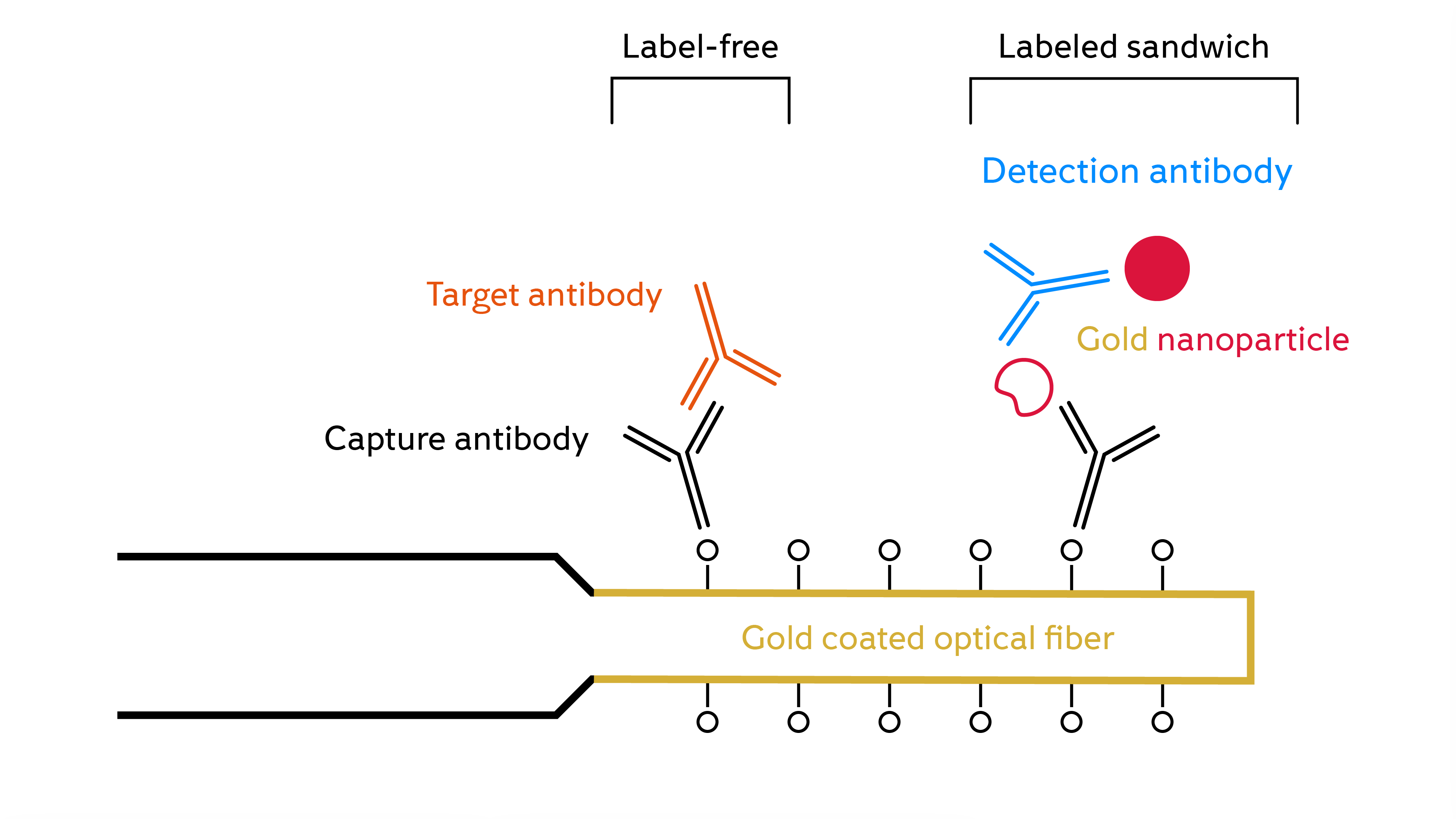Bioassays on Fiber Optic probe surface. The surface of the gold-coated fiber-optic probe has a carboxyl monolayer to which capture antibodies are covalently bound. Target antibodies bind the capture antibodies in a label-free configuration (left). Alternatively, the signal can be enhanced by using gold nanoparticles functionalized with detection antibodies in a sandwich assay configuration (right) extending detection to the pM and fM range.

WHITE FOx biosensors can accurately detect, quantify and measure the potency of your antibody of interest in a variety of sample matrices. Label-free pM to µM sensitivities in 10 minutes make our fiber-optic dip-in biosensor a versatile development tool.
- Fast assay time (10 min)
- Clinically relevant sensitivity is in reach of either label-free or fast labeled amplification assays
- Results better than ELISA, in much less time
- Minimum sample preparation (serum, plasma and whole blood)
Case study:
Therapeutic drug monitoring
Infliximab (IFX) is a monoclonal antibody used for the treatment of inflammatory bowel disease. Optimizing the therapeutic outcome requires concentration measurements which are currently obtained using the slow ELISA or less sensitive lateral flow-based immunotherapy techniques.
Immediate dose adaptation is a challenge using these techniques because they require well-trained staff, a long time to result, and sample prep on serum samples.
FOx BIOSYSTEMS offers an accurate, fast and convenient alternative to currently used techniques. This study showed that WHITE FOx biosensor provided excellent agreement with ELISA, even for serum and plasma samples.

Antibody concentrations obtained with
WHITE FOx correlate with those obtained with ELISA

Label-free potency screening of antibody–antigen interaction: reproducibly measure and rank potency across a library.
Case study:
Potency screening
Quick, label-free quantification of antibodies reveals no information about their functionality, since they could be denatured but still detected. By adding a second step to bind the target of the antibody, the signal relative to the amount of antibody present is a strong indication of its performance. This allows fast and sensitive measurement and ranking of the antigen-binding potency of a set of antibodies.
Relevant publications
Page 1 of 1
App Note: AN4 How to select your best performing single domain antibodies
A fast, dip-in assay can provide comprehensive kinetic analysis to determine the most appropriate binding proteins Single domain antibodies (sdAbs) have an improved capacity to penetrate tissues, making them powerful...
May 14, 2024
White paper: WP10 Kinetic analysis of VHH and antibodies with WHITE FOx
White paper 10 | Version 1 | Tobias Zbik, Sarah Parmentier, Kris Ver Donck ABSTRACT The landscape of antibody research continuously evolves, with novel antibody variants such as VHH, antibody-drug...
April 23, 2024
Development and validation of an optical biosensor for rapid monitoring of adalimumab in serum of patients with Crohn’s disease
Bian et al. (2017) RPTH 7, doi: 10.1002/dta.2250 Therapeutic drug monitoring of adalimumab is recommended to improve therapeutic outcome in patients with Crohn’s disease. Performing an ELISA requires a rather…
January 29, 2024
White paper: WP8 Affinity determination of single domain antibodies for detection of biomarkers
White paper 8 | Version 2 | Laura Marin, Sarah Parmentier, Kris Ver Donck, Filip Delport SUMMARY Single domain antibodies (sdAbs) and adhirons are an alternative to conventional antibodies for...
November 20, 2023
White paper: WP7 Versatile and fast IgG screening with the Protein A sensor probe
White paper 7 | Version 2 | Kris Ver Donck, Filip Delport, Laura Marin, Emma Buchet, Kim Stevens SUMMARY FOx BIOSYSTEMS’ fiber-optic surface plasmon resonance technology (FO-SPR) is a robust...
March 20, 2023
Detection of Breast Cancer-Specific Extracellular Vesicles with Fiber-Optic SPR Biosensor
Yildizhan et al. (2023) International Journal of Molecular Sciences DOI: 10.3390/ijms24043764 Extracellular vesicles (EVs) have attracted great attention as potential biomarkers for cancer diagnostics. Although several technologies have been developed…
February 15, 2023
Innovative FO-SPR Label-free Strategy for Detecting Anti-RBD Antibodies in COVID-19 Patient Serum and Whole Blood
Qu et al. (2022) ACS Sensors DOI: 10.1021/acssensors.1c02215 The ongoing COVID-19 pandemic has emphasized the urgent need for rapid, accurate, and large-scale diagnostic tools. Next to this, the significance of…
January 27, 2022
White paper: WP4 Label-free quantification in bioproduction samples
White paper 4 | Version 4 | Kris Ver Donck², Dagmara Minczakiewicz², Kim Stevens², Gert Struys¹, Thomas Geuens¹, Koen Dierckx¹, Filip Delport² ¹simAbs NV, ²FOx BIOSYSTEMS ABSTRACT This white paper...
October 1, 2021
Gold nanoparticle enhanced multiplexed biosensing on a fiber optic surface plasmon resonance probe
Qu et al. (2021) Biosensors and Bioelectronics 192, 113549 We present an innovative multiplexing concept on a fiber optic surface plasmon resonance (FO-SPR) platform and demonstrate for the first time…
August 24, 2021
White paper: WP3 Sensitive protein quantification in whole blood, dried blood spots, serum and plasma
White paper 3 | Version 2 | Kim Stevens, Kris Ver Donck, Filip Delport Based on original publication: Lu et al. (2017) Analytical Chemistry 89, 3664-3671. (1) ABSTRACT Fiber-optic surface...
June 29, 2021
White paper: WP2 sensitive protein quantification in serum – comparison of FO-SPR and ELISA
White paper 2 | Kim Stevens, Kris Ver Donck, Filip Delport Based on original publication: Lu et al. (2016) Biosensors and Bioelectronics 79, 173–179. (1) ABSTRACT This white paper demonstrates...
April 23, 2021
White paper: WP1 carboxyl probe immobilization for label-free protein quantification
White paper 1 | Filip Delport, Dagmara Minczakiewicz, Kris Ver Donck ABSTRACT This white paper describes a general strategy for optimizing immobilization on the FO-SPR probes and provides some reference...
March 31, 2021
Immunoassay for detection of infliximab in whole blood using a fiber-optic surface plasmon resonance biosensor
Lu et al. (2017) Anal. Chem. 89, 3664−3671 Monitoring the concentration of a therapeutic drug antibody, infliximab (IFX), is recommended for enhancing its efficacy in patients with inflammatory bowel…
February 22, 2017
Fiber optic-SPR platform for fast and sensitive infliximab detection in serum of inflammatory bowel disease patients
Lu et al. (2016) Biosensors and Bioelectronics 79, 173–179 Infliximab (IFX) is a therapeutic monoclonal antibody used for treating patients with inflammatory bowel disease (IBD). In order to improve…
May 15, 2016
Probing the force-induced dissociation of aptamer-protein complexes
Perez-Ruiz et al. (2014) Anal. Chem. 86, 3084−3091 Aptamers are emerging as powerful synthetic bioreceptors for fundamental research, diagnostics, and therapeutics. For further advances, it is important to gain…
February 20, 2014
Selection of aptamers against Ara h 1 protein for FO-SPR biosensing of peanut allergens in food matrices
Tran et al. (2013) Biosensors and Bioelectronics 43, 245–251 The rising prevalence to food allergies in the past two decades, together with the fact that the only existing therapy…
May 15, 2013
Fast and accurate peanut allergen detection with nanobead enhanced optical fiber SPR biosensor
Pollet et al. (2011) Talanta 83, 1436–1441 This paper is the first report of a fiber optic SPR biosensor with nanobead signal enhancement. We evaluated the system with a…
February 15, 2011
Fiber optic SPR biosensing of DNA hybridization and DNA–protein interactions
Pollet et al. (2009) Biosensors and Bioelectronics 25, 864–869 In this paper we present a fiber optic surface plasmon resonance (SPR) sensor as a reusable, cost-effective and label free biosensor for measuring DNA hybridization and DNA–protein…
December 15, 2009
Page 1 of 1
For Research Use Only. Not for use in diagnostic procedures.

